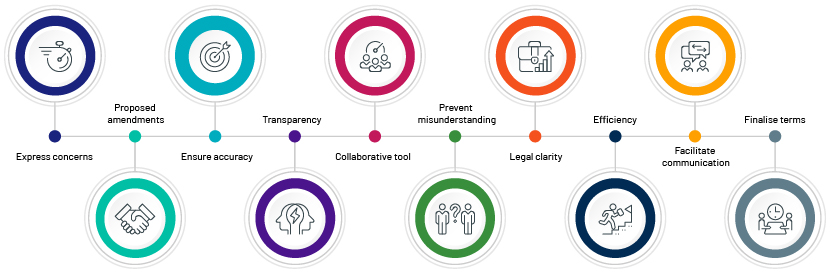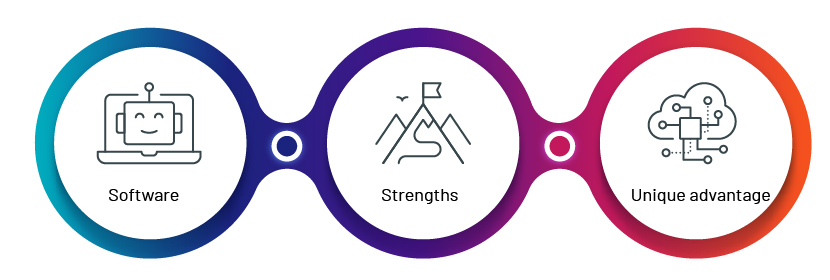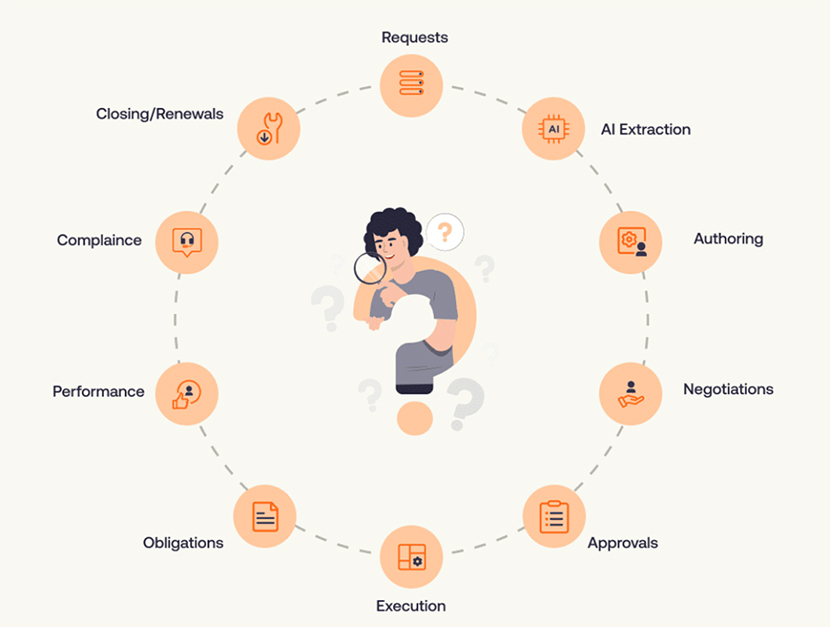Published on November 19, 2024 by Akash and Akshita Jasrotia
What is redlining?
“Redlining” refers to the process of making edits, additions or deletions to the original document to clearly differentiate the changes requested. Redlining a contract typically happens during a contract’s negotiation phase. The parties to the contract review it and highlight edits or changes they would like to make, including requests for certain terms and clauses to be edited, added or removed.[1]
The term “redlining” is derived from the traditional method of editing hard copies of contracts. In the past, hard copies were printed and shared with the other parties, which made changes in red. These redlined copies were then distributed again for accepting the changes or making additional changes. Today, however, contracts are often reviewed with modern tools such as Microsoft Word.[2]
Ninety-one percent of the lawyers surveyed in a recent poll on LinkedIn[3] said they use Microsoft Word and the Track Changes function for this purpose.
When to redline
This process provides a good opportunity for the parties to a contract to negotiate on the contractual terms prior to signing the contract.
The significance of contract redlining[4]

Effective ways of redlining contracts
1. Use digital collaboration tools: This refers to using online collaboration platforms that enable multiple parties to work on the same document simultaneously. This helps streamline the redlining process and reduces delay.
The following are details of some[5] AI-powered redlining and negotiation software for streamlining collaboration and accelerating the contract review process.

| Software | Strengths | Unique advantage |
| HyperStart CLM | Automates manual processes with 99.99% accuracy, 75% reduction in negotiation time, 10x faster review | AI Smart Assist streamlines redlining by handling both your and the counterparty’s papers efficiently |
| DocuSign CLM | Collaborative editor for redlining with version control, detailed audit trails, and seamless collaboration | Integrated eSignature capability ensures that redlined documents are easily signed and finalised |
| Agiloft | Highly flexible and customisable, powerful AI for automated redlining and clause management | AI-driven redlining automates complex edits and clause management, reducing manual effort |
| Concord | User-friendly interface, real-time collaboration, version-control capabilities | Real-time redlining and collaborative editing features enhance negotiation efficiency and accuracy |
| PandaDoc | Intuitive redlining with real-time commenting, tracking changes | Real-time commenting and change tracking facilitate a more interactive and efficient redlining process |
2. Be transparent in communication: Establishing clear guidelines leads to a transparent and consistent approach with documents. This would further minimise misunderstanding during the process and ensure that feedback is conveyed effectively among stakeholders.
3. Use version-control systems: These can track and manage alterations, enabling easy access to previous versions and reducing the risk of error associated with manual tracking.
4. Deploy a centralised contract management system: Integrating a CLM tool for contract management can help streamline the reviewing process, as a document often has to pass through different individuals and teams for approval. Having a centralised system can help overcome such issues.

5. Train stakeholders: Train those involved in negotiations and sales to ensure they are fully conversant with the terms and processes. This reduces the chance of error, improving overall efficiency.
6. Involve legal expertise: Engage legal experts early in the redlining process to ensure the proposed alterations are in line with legal requirements. This helps mitigate potential legal risks, improving the quality of the final contract.
7. Streamline approval processes: Set clear workflows and approval processes to expedite decision-making, prevent bottlenecks and ensure timely completion of the redlining process.
At a time when precision and speed are crucial, these recommendations pave the way for more efficient, transparent and secure negotiations in the dynamic landscape of contract management.
Conclusion
Contract redlining is a vital step in the negotiation process, serving as the backbone for clear communications and mutual understanding between the parties concerned. The contract negotiation phase is one stage of the CLM process that remains largely unaddressed by technology. By meticulously reviewing and revising contractual terms, stakeholders can mitigate risks, minimise miscommunication and pave the way for strong business commitments and relationships. By using better technologies and tools, contract negotiations can become more efficient and smoother.
How Acuity Knowledge Partners can help
By implementing all these strategies, we offer a skilled team experienced in contract lifecycle management with a focus on redlining. Through our Paralegal Outsourcing Services, our team can effectively identify, measure, and resolve issues during the negotiation process and help mitigate risk, maximising benefits and securing client interests. We help clients adopt these important practices to ensure smoother operations, stronger partnerships, and fulfilment of contractual obligations, resulting in sustained success and growth.
Sources:
-
Contract Redlining 101: An Introduction To The Art Of Effective Review And Revision
-
Contract Redlining: A Guide on What it is and How to Redline
-
[4] Contract Redlining 101: An Introduction To The Art Of Effective Review And Revision (legalconsultingpro.com)
-
[5] Contract Redlining: The Only Guide You Need in 2024 (hyperstart.com)
Tags:
What's your view?
About the Authors
Akash has been involved in managing various projects regarding drafting of contract templates and drafting various contracts like LPA, LLCA, Subscription Agreements etc. for an asset manager. He has also been involved in parsing of fund terms by abstracting and summarizing vital data from the formation till the dilution of funds for a leading sovereign wealth fund in Acuity Knowledge Partners
He holds over 5 years of experience in legal outsourcing industry to clients worldwide and managed contract drafting, reviewing, abstraction and summarization for some of the world’s largest IT, Pharma, Banking firms etc. He also specializes in using CLM and e-discovery platforms like Conga and Relativity.
Akshita has been involved in managing vendor contracts, handling over 150+ vendors. She oversees various subscription agreements, master service agreements, service contracts, order forms and terms to ensure they comply with the client's requirement and policies. She also tracks vital dates like renewal and termination and ensure timely reminders are sent to the client for the upcoming event, assisting them stay on top of their vendor agreements in Acuity Knowledge Partners.
Like the way we think?
Next time we post something new, we'll send it to your inbox





